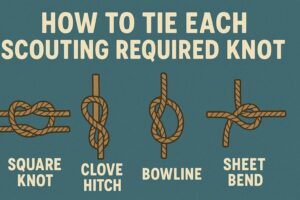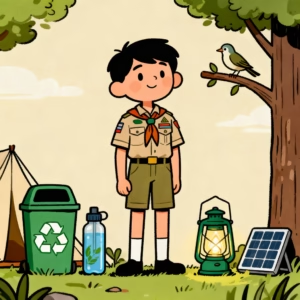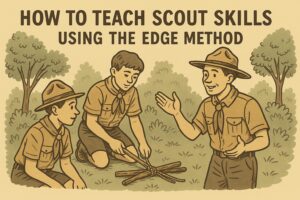Introduction
Knots are important life skill for anyone, but especially in Scouting. You probably tie a knot everyday in your shoes! In Scouting, there are 7 knots you’ll be required to tie and know the uses of. In this article I’ll break down each knot and give you all the knot tying skills for any situation you might come across. The 7 Scouting knots are:
- Square Knot (Tenderfoot 3a)
- Two Half-Hitches (Tenderfoot 3b)
- Taut-Line Hitch (Tenderfoot 3c)
- Sheet Bend (Second-Class 2f)
- Bowline (Second-Class 2g)
- Clove Hitch (First-Class 3b)
- Timber Hitch (First-Class 3b)
Each of these knots will serve one of 3 main purposes:
- Connecting two ropes together which is called a bend
- Connecting a rope to another object which is called a hitch
- Creating a loop in rope which is called, naturally, a loop
I got a lot of my information for this post from the site 101knots.com. You can click the picture for each knot for the link to their page on each of these knots for more information.
Square Knot (bend)
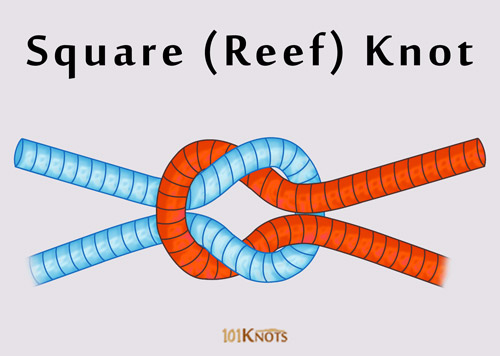
The square knots is one of the most simple knots out there. It is used to connect two lengths of rope that are the same thickness together. You may also see the square knot be called the reef knot. This short video will show you how to tie a square knot:
As a simple trick, I always remember “Left over right, right over left” when tying a square knot. One downside of the square knot is that it can slip when under a lot of strain. Some uses of the square knot include:
- Connecting two pieces of equal thickness rope
- Securing a long, thin bundle of items
- You can actually tie your shoes with a square knot
Two Half-Hitches (hitch)

Two half-hitches is another extremely simple and common knot. This video explains how to tie two half-hitches knot.
This knot creates an adjustable loop that can be used for a wide variety of purposes. These could include:
- Tieing down tent stakes
- Creating a clothes line
- Tieing down a load on a car
Taut-Line Hitch (hitch/loop)
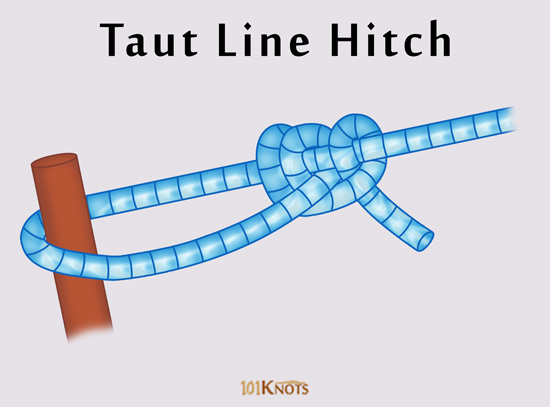
The taut-line hitch is one of the most useful knots and also my personal favorite knot. I have used this knot countless times both inside and outside of Scouting. This short video will teach you how to tie a taut-line hitch.
The taut-line hitch creates an adjustable loop that can easily be adjusted but also holds its shape very well. It is simple and easy to tie as well as untie. Some common uses of the taut-line hitch include:
- Tieing down loads
- Setting up hammocks
- Any time a two-half hitches knot might be used but more friction is needed
- For adjustable moorings in tidal areas
Sheet Bend (bend)

The sheet bend serves a similar purpose as the square knot. It is also used to combine two pieces of rope but has a more universal application. It is slightly harder to tie than the square knot but can combine two pieces of rope of different thicknesses.
As shown, the sheet bend can combine two lengths of rope of drastically different thicknesses. Uses include
- Combining two lengths of rope of different thicknesses
- Boating
- Mak
Bowline (loop)
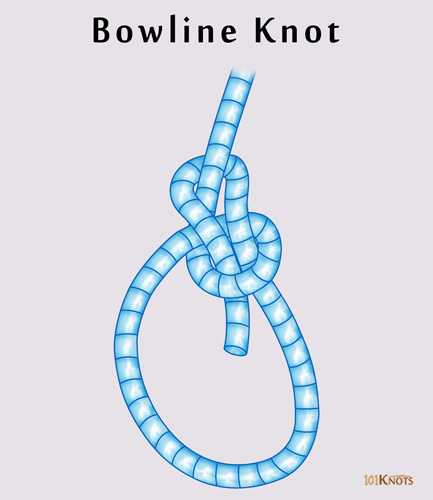
The bowline is another extremely commonly used knot. It creates a loop that holds its shape and does not tighten the knot under load. This video will show you how to tie a bowline:
A common mnemonic to remember how to this knot goes as follows; “There is a hole, a rabbit goes out of the hole, around the tree, back in the hole.” The bowline has a wide variety of uses:
- Creating a loop to throw to someone for a water rescue
- Tieing mooring lines
- Countless boating applications
The bowline is known by some as the most useful knot in the world. Different versions of the bowline were all developed independently by every early peoples that used boats.
Clove Hitch (hitch)
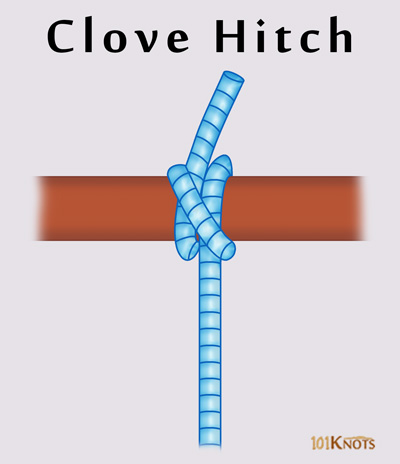
The clove hitch is a very simple knot that is easy to untie quickly. This video will show you how to tie it
Some uses of the clove hitch include:
- Starting and ending many lashings
- Tieing arm slings
- Tieing off the top of a tent stake bag
Timber Hitch (hitch)
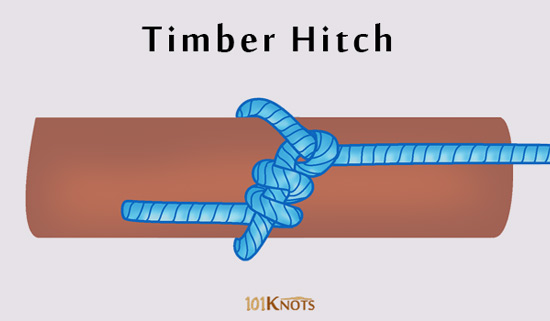
The timber hitch is a noose like knot that is used for, as you can probably guess, pulling timber. This video will show you how to tie it.
The timber hitch creates a loop that cinches tightly to the object its tied around without making the knot too tight to untie. To make the knot more secure you can add more loops around the inside end of the loop. It is used for:
- Pulling logs or sticks
- Hoisting logs or planks
- Ending a few lashings
Conclusion
Knot tieing is an important skill for all Boy Scouts. While a lot the fellow patrol members loathed having to learn knots, I enjoy and appreciate the beauty and uses that knots offer us. The 7 knot listed above can be combined in a countless number of ways to create anything you mind can think of. For example, at my final summer camp, my buddy and I created a shaded hang out spot with a tarp and just a few taut-line hitches
Knot knowledge opens a world of possibilities and I hope you will commit the 7 knots listed above to memory. For now, good luck on your path to eagle and happy Scouting.

